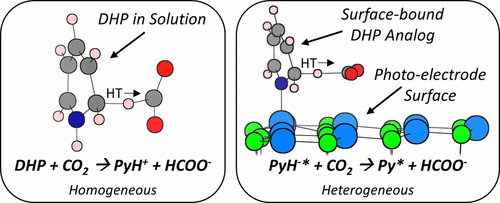当前位置:
X-MOL 学术
›
ACS Cent. Sci.
›
论文详情
Our official English website, www.x-mol.net, welcomes your
feedback! (Note: you will need to create a separate account there.)
The Role of Surface-Bound Dihydropyridine Analogues in Pyridine-Catalyzed CO2 Reduction over Semiconductor Photoelectrodes
ACS Central Science ( IF 12.7 ) Pub Date : 2017-08-25 00:00:00 , DOI: 10.1021/acscentsci.7b00233 Thomas P. Senftle 1 , Martina Lessio 2 , Emily A. Carter 3
ACS Central Science ( IF 12.7 ) Pub Date : 2017-08-25 00:00:00 , DOI: 10.1021/acscentsci.7b00233 Thomas P. Senftle 1 , Martina Lessio 2 , Emily A. Carter 3
Affiliation

|
We propose a general reaction mechanism for the pyridine (Py)-catalyzed reduction of CO2 over GaP(111), CdTe(111), and CuInS2(112) photoelectrode surfaces. This mechanism proceeds via formation of a surface-bound dihydropyridine (DHP) analogue, which is a newly postulated intermediate in the Py-catalyzed mechanism. Using density functional theory, we calculate the standard reduction potential related to the formation of the DHP analogue, which demonstrates that it is thermodynamically feasible to form this intermediate on all three investigated electrode surfaces under photoelectrochemical conditions. Hydride transfer barriers from the intermediate to CO2 demonstrate that the surface-bound DHP analogue is as effective at reducing CO2 to HCOO– as the DHP(aq) molecule in solution. This intermediate is predicted to be both stable and active on many varying electrodes, therefore pointing to a mechanism that can be generalized across a variety of semiconductor surfaces, and explains the observed electrode dependence of the photocatalysis. Design principles that emerge are also outlined.
中文翻译:

表面结合的二氢吡啶类似物在吡啶催化的半导体光电电极上CO 2还原中的作用
我们提出了在GaP(111),CdTe(111)和CuInS 2(112)光电极表面上吡啶(Py)催化还原CO 2的一般反应机理。该机制通过形成表面结合的二氢吡啶(DHP)类似物来进行,该类似物是Py催化机制中新假定的中间体。使用密度泛函理论,我们计算了与DHP类似物形成相关的标准还原电位,这表明在光电化学条件下在所有三个研究电极表面上形成该中间体是热力学可行的。氢化物从中间体到CO 2的转移障碍表明,表面结合的DHP类似物在减少CO 2方面同样有效到HCOO –作为溶液中的DHP (aq)分子。预测该中间体在许多变化的电极上既稳定又有活性,因此指出了可以在各种半导体表面上推广的机理,并解释了所观察到的电极对光催化的依赖性。还概述了出现的设计原则。
更新日期:2017-08-25
中文翻译:

表面结合的二氢吡啶类似物在吡啶催化的半导体光电电极上CO 2还原中的作用
我们提出了在GaP(111),CdTe(111)和CuInS 2(112)光电极表面上吡啶(Py)催化还原CO 2的一般反应机理。该机制通过形成表面结合的二氢吡啶(DHP)类似物来进行,该类似物是Py催化机制中新假定的中间体。使用密度泛函理论,我们计算了与DHP类似物形成相关的标准还原电位,这表明在光电化学条件下在所有三个研究电极表面上形成该中间体是热力学可行的。氢化物从中间体到CO 2的转移障碍表明,表面结合的DHP类似物在减少CO 2方面同样有效到HCOO –作为溶液中的DHP (aq)分子。预测该中间体在许多变化的电极上既稳定又有活性,因此指出了可以在各种半导体表面上推广的机理,并解释了所观察到的电极对光催化的依赖性。还概述了出现的设计原则。











































 京公网安备 11010802027423号
京公网安备 11010802027423号